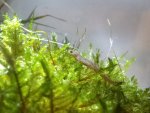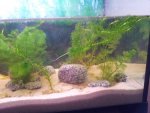Iksee
New member
Hello all, just joined these forums and seeking some advice.
I bought my first FBN on the 21st of Feb as my local exotics store only had the one come in. He's quite a big fella, not skinny or anything however he never goes in the water on his own accord and as of yet to my knowledge he still has not eaten.
He has been in the water twice as I removed his cork bark once to clean it as it had some waste on. He seems to be fine in the water acting as any newt would but after an hour or two he always went back to the cork bark and stayed on there.
For food I was given some frozen tubifex which he has not taken and frankly is quite a nuance to feed to a terrestrial newt as it sort of clumps together and sticks to everything.
I returned to the exotics store Sat 2nd of March, with me I brought a sample of my water to get tested to make sure I read my 6 in 1 water test correctly, the owner done the water test for me and said everything was in the good, although my ammonia levels were about to go into the yellow in the next few days, which is understandable as I am due a partial water change tomorrow.
I asked him what he would advise to feed my terrestrial newt and he suggested fruit flies, springtail and some young banded crickets, I opted for the crickets as they seemed an easier method of getting them into the aquarium but as far as I am aware I do not think he has eaten any. I also purchased some sphagnum moss to help keep my terrestrial one moist.. I also bought my second CFBN that day and he's been in the water since, acts all normal and active even ate the tubifex worms couple of hours after adding them, the new one is a bit smaller than my first one and thinner.
Can anyone advise me on any other foods I could try feeding him? I did try an earthworm that I found in my local woodland a few days after getting him but he did not take to that either.
Thanks in advance and sorry if the post seems lengthy just wanted to give more information to give my question some context.
I bought my first FBN on the 21st of Feb as my local exotics store only had the one come in. He's quite a big fella, not skinny or anything however he never goes in the water on his own accord and as of yet to my knowledge he still has not eaten.
He has been in the water twice as I removed his cork bark once to clean it as it had some waste on. He seems to be fine in the water acting as any newt would but after an hour or two he always went back to the cork bark and stayed on there.
For food I was given some frozen tubifex which he has not taken and frankly is quite a nuance to feed to a terrestrial newt as it sort of clumps together and sticks to everything.
I returned to the exotics store Sat 2nd of March, with me I brought a sample of my water to get tested to make sure I read my 6 in 1 water test correctly, the owner done the water test for me and said everything was in the good, although my ammonia levels were about to go into the yellow in the next few days, which is understandable as I am due a partial water change tomorrow.
I asked him what he would advise to feed my terrestrial newt and he suggested fruit flies, springtail and some young banded crickets, I opted for the crickets as they seemed an easier method of getting them into the aquarium but as far as I am aware I do not think he has eaten any. I also purchased some sphagnum moss to help keep my terrestrial one moist.. I also bought my second CFBN that day and he's been in the water since, acts all normal and active even ate the tubifex worms couple of hours after adding them, the new one is a bit smaller than my first one and thinner.
Can anyone advise me on any other foods I could try feeding him? I did try an earthworm that I found in my local woodland a few days after getting him but he did not take to that either.
Thanks in advance and sorry if the post seems lengthy just wanted to give more information to give my question some context.




